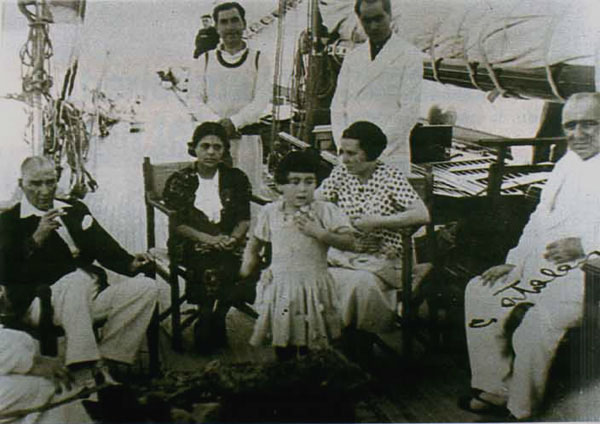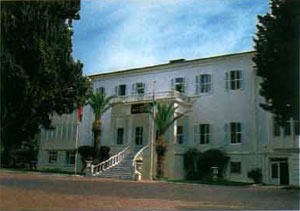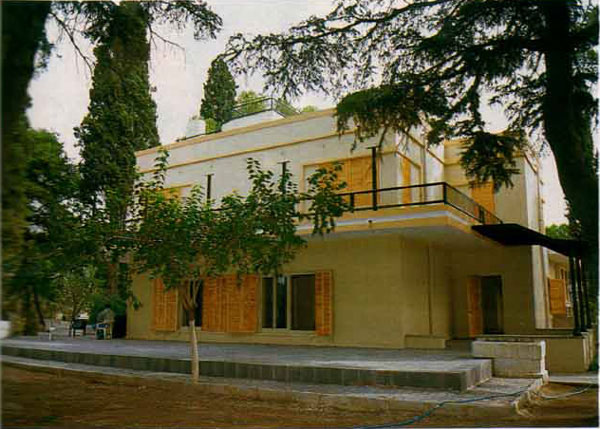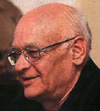The
house Alain Giraud lives in Bornova was built in 1850 by the first US
Consul of Izmir. Amongst the photos displayed on the walls is a pair
showing his grandfather Harold Giraud entertaining Ataturk in his yacht,
named Lilias. The two gentleman next to them are the late directors
of İş bank, Cemil Atalay and Sedat Evliyazade. Before Ataturk purchased
his own yacht, Savarona, he was welcomed as a guest in the Giraud summer
house in Ilica. Mr Giraud still remembers the time in the 1930s, and
despite like all other children in the household, ordered to their rooms
for Ataturk’s peace, he nevertheless was able to see him.
The walls are also adorned with portraits of ancestors in oils, such as the dark haired and piercing eyed beauty who was Mr Giraud’s paternal grandmother, from the Giustiniani family, originally from Venice, one member of which was the leader of the Byzantine palace guard at the time of the fall of Constantinople to the Ottomans. This family lived for centuries on the Aegean island of Chios. There are also portraits of the groom of one of the early Giraud’s, the English Charlton Whittall and his son.
The walls are also adorned with portraits of ancestors in oils, such as the dark haired and piercing eyed beauty who was Mr Giraud’s paternal grandmother, from the Giustiniani family, originally from Venice, one member of which was the leader of the Byzantine palace guard at the time of the fall of Constantinople to the Ottomans. This family lived for centuries on the Aegean island of Chios. There are also portraits of the groom of one of the early Giraud’s, the English Charlton Whittall and his son.
 |
Atatürk on Harold Giraud’s yacht, the Lillias, 1930s.
The ancestry of
Alain Giraud includes branches from Byzantium, Chios, Venice and in
1761, from the southern French town of Antibes, Jean Baptist Giraud
who was sent as an agent by a Marseilles based trading company.
Also on display on the walls are oil paintings of two young men, brothers of his grandfather’s who died for the French nation, in the trenches in Verdun. Ironically Harold Giraud was providing uniforms to the Ottoman army at the same time from his textile factory he established in Izmir in 1913, with the result that after the war, the Giraud family nearly lost their French citizenship; the authorities there unable to understand why they carried on living in Turkey. Mr Giraud still feels gratitude that the land of Turkey has never seen him or his family as enemy.
When Jean Baptiste Giraud came to Izmir in 1761, he was a bachelor but married and had children in the city, establishing the local family line; he is buried as a Catholic in the St. Polycarp cemetery. His grandson Jean Baptiste II, married the Dutch Protestant
Also on display on the walls are oil paintings of two young men, brothers of his grandfather’s who died for the French nation, in the trenches in Verdun. Ironically Harold Giraud was providing uniforms to the Ottoman army at the same time from his textile factory he established in Izmir in 1913, with the result that after the war, the Giraud family nearly lost their French citizenship; the authorities there unable to understand why they carried on living in Turkey. Mr Giraud still feels gratitude that the land of Turkey has never seen him or his family as enemy.
When Jean Baptiste Giraud came to Izmir in 1761, he was a bachelor but married and had children in the city, establishing the local family line; he is buried as a Catholic in the St. Polycarp cemetery. His grandson Jean Baptiste II, married the Dutch Protestant
Annette
de Hochepied, thus early on, like many other Levantines, overcame national
and religious differences and created their own cultural world through
this melt-pot.
The saying ‘gavur’ [infidel] Izmir was used even after the population exchange, as Mr Giraud points out, the Turkish immigrant families from the Balkans living in neighbourhoods previously occupied by Christians of the city, continued to speak Greek amongst each other. Mr Giraud like many of his generation learnt Greek before Turkish, but without being able to read or write it. The Greek spoken by Mr Giraud however is instantly recognisable in Greece as ‘Smyrna’ Greek, which they find highly amusing.
Until around the end of the Second World War, our relations with our Turkish neighbours were distant as they were not accustomed to an environment where women were present. The First Turk to come to our house as a visitor was Sedat Evliyazade, whose father owned large tracts of land in Söke / Aydın and was keen on horses. My father was also very keen on horses and would attend the major local horse races of Cumhuriyet Koşusu and Gazi Koşusu. This enthusiasm for horses is now continued by my brother Herve who still rides every day and in the past would join the races. Herve’s two daughters also share a love of horses and the older Caroline met her future husband Mustafa Koç while riding.
For my primary schooling I went to the local French Saint Joseph and later for secondary education, the English High School in Istanbul (now the Nişantaşı Anadolu lisesi), for my upper education in a lycée in France and for university was in England. Upon graduation went to Canada where I spent 7 years, but nostalgia for Izmir and Çesme / Ilıca drew me back again here.
The chief reason why Levantines first came to Izmir is undoubtedly their wish to benefit from the concessions of ‘capitulations’. But when these concessions were rescinded, most of these families had established such firm links to the place, they didn’t consider returning.
Despite the many national bloods I carry, I consider myself to be mostly French and because of my interest in technology and consequent imprint of American culture, and the fact that I speak English more frequently than French, I also consider myself to be an Anglo-Saxon. However despite not having nationalistic feelings, my heart is with Turkey, a land that didn’t expel me with the enemy, allowed me to make money and made me what I am. In the past both communities didn’t want to mix and there were cultural obstacles. Now the mixing is almost complete, for example I know of an Italian family that speaks amongst each other in Turkish, and when I go to church for a funeral, sometimes even the priest conducts the ceremony in Turkish.
A lady from the Ege University, Professor Serap Yılmaz, went to Antibes and examined all the family records there, confirming what we already knew.
Turkey has a difference place in the Moslem world, a country that is open to change and not opposed to marriage with foreigners. The Giraud family tree with each generation gets more complex with the infusion of new bloods, moving away from the Levantine mix of generations back, the Whittall, Giustiniani, La Fontaine, Hochepied, Wilkinson, Fidao etc., to the Turkish family names now entering, Şentepe, Tengiz, Koç, Erdoğan, Aktay. The Levantines without losing their identity, transform themselves with the times, adding cultural colour to the city of Izmir. For Mr Giraud, Izmir is a unique city, Levantines who migrated originally to make money were eventually absorbed by the city, their principal characteristic with time was no longer what country they came from, but being an ‘Izmirli’. Alain too, realised after 7 years in Canada he couldn’t settle anywhere else, and would not consider moving elsewhere.
The saying ‘gavur’ [infidel] Izmir was used even after the population exchange, as Mr Giraud points out, the Turkish immigrant families from the Balkans living in neighbourhoods previously occupied by Christians of the city, continued to speak Greek amongst each other. Mr Giraud like many of his generation learnt Greek before Turkish, but without being able to read or write it. The Greek spoken by Mr Giraud however is instantly recognisable in Greece as ‘Smyrna’ Greek, which they find highly amusing.
Until around the end of the Second World War, our relations with our Turkish neighbours were distant as they were not accustomed to an environment where women were present. The First Turk to come to our house as a visitor was Sedat Evliyazade, whose father owned large tracts of land in Söke / Aydın and was keen on horses. My father was also very keen on horses and would attend the major local horse races of Cumhuriyet Koşusu and Gazi Koşusu. This enthusiasm for horses is now continued by my brother Herve who still rides every day and in the past would join the races. Herve’s two daughters also share a love of horses and the older Caroline met her future husband Mustafa Koç while riding.
For my primary schooling I went to the local French Saint Joseph and later for secondary education, the English High School in Istanbul (now the Nişantaşı Anadolu lisesi), for my upper education in a lycée in France and for university was in England. Upon graduation went to Canada where I spent 7 years, but nostalgia for Izmir and Çesme / Ilıca drew me back again here.
The chief reason why Levantines first came to Izmir is undoubtedly their wish to benefit from the concessions of ‘capitulations’. But when these concessions were rescinded, most of these families had established such firm links to the place, they didn’t consider returning.
Despite the many national bloods I carry, I consider myself to be mostly French and because of my interest in technology and consequent imprint of American culture, and the fact that I speak English more frequently than French, I also consider myself to be an Anglo-Saxon. However despite not having nationalistic feelings, my heart is with Turkey, a land that didn’t expel me with the enemy, allowed me to make money and made me what I am. In the past both communities didn’t want to mix and there were cultural obstacles. Now the mixing is almost complete, for example I know of an Italian family that speaks amongst each other in Turkish, and when I go to church for a funeral, sometimes even the priest conducts the ceremony in Turkish.
A lady from the Ege University, Professor Serap Yılmaz, went to Antibes and examined all the family records there, confirming what we already knew.
Turkey has a difference place in the Moslem world, a country that is open to change and not opposed to marriage with foreigners. The Giraud family tree with each generation gets more complex with the infusion of new bloods, moving away from the Levantine mix of generations back, the Whittall, Giustiniani, La Fontaine, Hochepied, Wilkinson, Fidao etc., to the Turkish family names now entering, Şentepe, Tengiz, Koç, Erdoğan, Aktay. The Levantines without losing their identity, transform themselves with the times, adding cultural colour to the city of Izmir. For Mr Giraud, Izmir is a unique city, Levantines who migrated originally to make money were eventually absorbed by the city, their principal characteristic with time was no longer what country they came from, but being an ‘Izmirli’. Alain too, realised after 7 years in Canada he couldn’t settle anywhere else, and would not consider moving elsewhere.
I
have often been asked by friends to write a sequel to the Edmund Giraud,
‘Family Records’ book that takes the family story till 1935. However
despite wanting to write, I find writing a ‘lonely’ state of mind. One
is forever having to reassess the past, did that person think this way
or that, did my father use those words and such like. When it flows
out from you, its nice and easy, but sometimes you force yourself to
sit down and it becomes like a forced lesson of a student, and then
you write with uncertainty. Another factor is the real active period
of Levantines pre-date me and so I don’t have that information. So what
I will write will resemble those written by other modern Levantines,
the disappearance of Levantine culture, like witnessing a funeral. The
famous family names are disappearing, there are no Charnauds left and
the sole Whittall is a lady, yet these families once had businesses
all across Turkey. So there is an imperative need to write this all
down, but sometimes I wonder, who would it interest?
These major changes were brought about because once the country needed these people,
These major changes were brought about because once the country needed these people,
 |
The former Big House of Bornova, now part of the local university.
now
no longer. Alain remembers in his childhood there were four or five
Turkish doctors, now they are everywhere. It’s the same in engineering,
finance and other disciplines. Turkey has developed its own capacity.
The only missing specialists are in research and development, which
Turkey imports, but with time even this knowledge gap would be plugged.
The private sector has already realised the knowledge base is built
in universities and conglomerates such as Sabancı and Koç have opened
their own named universities, not just for benevolent reasons, but also
to make money, by ensuring they would be the first hand to receive that
knowledge.
In the past Levantines established many clubs helping to create a lively social scene in Izmir. Many sporting clubs were also established by Levantines, such as the first football club in Turkey was founded by the father of my mother, James La Fontaine in Istanbul, at the turn of the century.
In the past Levantines established many clubs helping to create a lively social scene in Izmir. Many sporting clubs were also established by Levantines, such as the first football club in Turkey was founded by the father of my mother, James La Fontaine in Istanbul, at the turn of the century.
 |
Alain Giraud’s former house in Bornova.
There is no mass
migration of Levantines to the west, as there are so few of them left
and many of those left are mostly middle class with their children going
to Turkish schools. My own daughter, Haydee, who has graduated in architecture
in Turkish has a Turkish mentality, and despite me speaking English
with her in her childhood and going to the American Girl’s school in
Izmir, speaks English with a Turkish accent, and her husband is an American.
I see in the future many Levantines even changing their names to Turkish.
I remember as a child when I played football, they used to call me ‘Ali’,
which I don’t mind as I am not seen as a foreigner here. Yet when I
go to France, I feel like a foreigner. Yet I did my military service
there, and when they saw where he was born, they would ask, ‘what are
you doing here?’ and was given nick names such as ‘Mustafa’. I stayed
in France for 5 or 6 years, yet when I first went to France I couldn’t
speak French, but after 3 years I was fluent and had lost my Levantine
accent. Yet today if you use
the word ‘Levantine’ nobody would understand you, it is concept lost to the
new generation.
I could have stayed in France, but was not at home there, even though
I do have some relatives I am in occasional contact with. However my
way of looking at things is different and I see a chauvinistic streak
over there which I would not be comfortable with. Maybe the Levantine
advantage of knowing different cultures gave them a wider outlook. It
prevented them being preconceived and prejudiced against Islam and the
Turks. So there were a few advantages and we are indebted to their generosity.
I don’t approve of all the Turks’ national characteristics, but I see
eye to eye and walk on the same platform with them.
The houses of Bornova have often changed hands and one of the most prominent ones, the Charlton Whittall house was later a Giraud house before it became the Ege university rectorship. Also within the grounds of this university stand the house of Will Giraud, the father of Alain. According to the book by Evelyn Kalças, ‘Gateways to the past’, many famous people stayed in these houses, Lord Byron, Lamartine and Pierre Loti. Alain Giraud sees some of these stories as unreliable legends. However he remembers the young Queen Elizabeth, then the fiancée of Prince Philip, visiting their house. My mother had a table cloth and would make all famous visitors sign it, including Queen. We still have that table cloth, but no longer use it as such.
Notes: 1-This contribution is based on a Turkish article published in the November 2002 edition of the local publication, ‘Izmir life’, and Mr Giraud has kindly given permission for this translation. I have deviated slightly from the original text to maintain relevance to this study.
2- Mr Giraud was one of a group of people who were video interviewed under a project titled ‘Some of them say Levantine to them’, a documentary film built through interviews of Levantine descendants and Turkish historians of Izmir, directed by Ragıp Taranç, and produced in association with the Izmir Goethe Institute, Izmir Centre Culturel Français, and the Dokuz Eylül University in Izmir, Faculty of Fine Art, Department of Cinema-TV, in 2005 - details.
3- A distant uncle to Alain Giraud was a successful businessman, Charlton James Giraud (1869-1955), who married the Levantine Esther Wilkinson and was the son of Frederick Jacques Giraud (1837-1922) and Mary (née Whittall - 1843-1932). The C.J. Giraud company was founded in 1914 was responsible for principally the export of dried fruit, and a contributor, Onur İnal has kindly provided the images from a trade catalogue intended to customers in Hamburg, Germany, photos providing a glimpse of their trade in the 1920s, viewable here:
4- Further Giraud family group photos viewable here:
5- A cousin of Alain, Brian Giraud (son of Godfrey Bertram (1907-1987) > Edmund Haydn (1880-1962) > Frederick Jacques Giraud (1843-1932), the common gr-grandfather as one of his sons was Harold Frederick (1872-1963) > William > Raymond Alain Giraud) contributed an article on the ‘History of Yachting in Turkey’, penned in 2010.
5- Unfortunately, Mr Alain Giraud died on 25-11-2005 and is now buried in the Bornova Anglican cemetery...God bless his soul.
6- In the summer of 2010 Mr Nedim Sonmez, the coordinator of the 50th Year Mansion Art Gallery of Ege University, prepared a photographic exhibition of the 10 former Levantine houses of Bornova, highlighting their history, now under the university control, with an accompanying booklet - the pdf summary version of this is viewable here in English:, French: and Turkish: Both Brian Giraud and Jean-Pierre Giraud assisted as consultants and for translation purposes.
The houses of Bornova have often changed hands and one of the most prominent ones, the Charlton Whittall house was later a Giraud house before it became the Ege university rectorship. Also within the grounds of this university stand the house of Will Giraud, the father of Alain. According to the book by Evelyn Kalças, ‘Gateways to the past’, many famous people stayed in these houses, Lord Byron, Lamartine and Pierre Loti. Alain Giraud sees some of these stories as unreliable legends. However he remembers the young Queen Elizabeth, then the fiancée of Prince Philip, visiting their house. My mother had a table cloth and would make all famous visitors sign it, including Queen. We still have that table cloth, but no longer use it as such.
Notes: 1-This contribution is based on a Turkish article published in the November 2002 edition of the local publication, ‘Izmir life’, and Mr Giraud has kindly given permission for this translation. I have deviated slightly from the original text to maintain relevance to this study.
2- Mr Giraud was one of a group of people who were video interviewed under a project titled ‘Some of them say Levantine to them’, a documentary film built through interviews of Levantine descendants and Turkish historians of Izmir, directed by Ragıp Taranç, and produced in association with the Izmir Goethe Institute, Izmir Centre Culturel Français, and the Dokuz Eylül University in Izmir, Faculty of Fine Art, Department of Cinema-TV, in 2005 - details.
3- A distant uncle to Alain Giraud was a successful businessman, Charlton James Giraud (1869-1955), who married the Levantine Esther Wilkinson and was the son of Frederick Jacques Giraud (1837-1922) and Mary (née Whittall - 1843-1932). The C.J. Giraud company was founded in 1914 was responsible for principally the export of dried fruit, and a contributor, Onur İnal has kindly provided the images from a trade catalogue intended to customers in Hamburg, Germany, photos providing a glimpse of their trade in the 1920s, viewable here:
4- Further Giraud family group photos viewable here:
5- A cousin of Alain, Brian Giraud (son of Godfrey Bertram (1907-1987) > Edmund Haydn (1880-1962) > Frederick Jacques Giraud (1843-1932), the common gr-grandfather as one of his sons was Harold Frederick (1872-1963) > William > Raymond Alain Giraud) contributed an article on the ‘History of Yachting in Turkey’, penned in 2010.
5- Unfortunately, Mr Alain Giraud died on 25-11-2005 and is now buried in the Bornova Anglican cemetery...God bless his soul.
6- In the summer of 2010 Mr Nedim Sonmez, the coordinator of the 50th Year Mansion Art Gallery of Ege University, prepared a photographic exhibition of the 10 former Levantine houses of Bornova, highlighting their history, now under the university control, with an accompanying booklet - the pdf summary version of this is viewable here in English:, French: and Turkish: Both Brian Giraud and Jean-Pierre Giraud assisted as consultants and for translation purposes.
